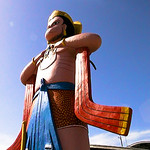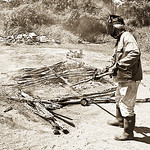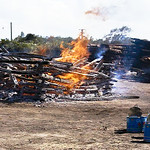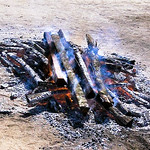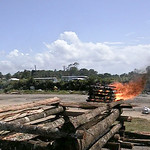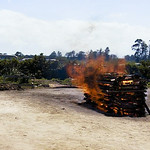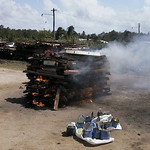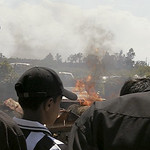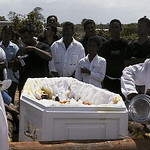A Hindu cremation
I already had heard that the Hindustani population still cremated bodies in open air, here. This usually happened at 'op weg naar zee', a street running from the Kwattaweg, the main connection from Paramaribo eastwards, to the sea.
When I noticed an obituary giving notice of a cremation, we just had to go. Betsy thought it was only a short walk towards the sea shore from the Kwattaweg, but I had doubts. The road turned out to be eight kilometers long.
Luckily, we were picked up by the friendliest Hindustani couple, who also were going to a cremation. As it turned out, we got along very well with Kamta and Lila and they not only invited us home, but also drove us all around Commewijne later on, visiting old plantations like Peperpot and Marienburg.
Although four stakes were set up, only three cremations were held that day. Under a large roof, long benches were placed next to one another for family and friends to 'enjoy' the fire after the appropriate ceremonies had been held.
The boy whom Kamta and Lila had come to visit had committed suicide at the tender age of 16. After the coffin was brought in, it was placed on top of one of the stakes with an open lid. One person held a parasol above the boy's head (to shield him from the sun?) while the rest walked around the stake, sprinkling yellow flowers and salt over his head.
Earlier, someone had opened many boxes of gee (fat) which were poured over the stake, the coffin and the body. Not, however, before the boy's mother, full of emotion, had come back multiple times to cry over her son. Shortly after that, the stake was lit, near the head.
Not all three ceremonies were identical. Many people who had come for the 'second' stake had shaved their heads, leaving only a small ponytail. When they brought in that particular coffin, they continuously chanted, placing the coffin on the ground every two meters or so before it was put on the stake.
Although some people did get emotional, here, mostly everyone was very relaxed. Shortly after the stakes had been lit, everybody started chatting and several people came in with drinks to hand out. On quieter spots, little children were playing with each other.
In less then an hour, the three stakes were nothing more than small heaps of ashes. Not everything was burned, though. It was still possible to discern a piece of skull here, some ribs there.
Later I heard the rituals would continue the next day. The direct family would come back with a bowl of milk, covered in the same orange flowers that were used before. They would sprinkle the milk over the ashes, to wash the bones, and then pick out the remains, the little bones, from the ashes and put them in a blanket. The blanket with the bones inside, would be washed again. Then, the remains would be distributed over flowing water, such as the mouth of the Suriname river.
